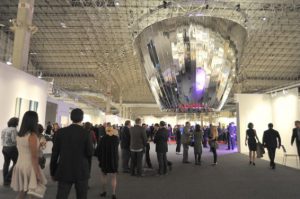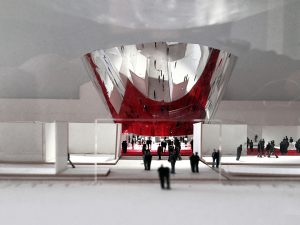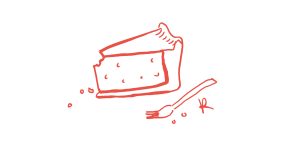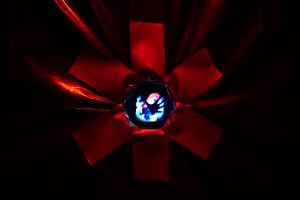![]() Frontispiece and The Uncanny Imagination are projects by Becket Flannery and Grant Ray, respectively, that constitute a two-person exhibition at ACRE Projects. Part of ACRE’s year-long series of shows by 2010 summer residents, their work finds common ground not only through the photographic medium, but also through their exploration of the narrative and the dynamic between images and narratives, often social in derivation. As the artists began installing their exhibition on March 8, I spent the afternoon with them discussing, among other topics, political theorists, hoaxes, New York nostalgia, and late-night woodshop dance parties.
Frontispiece and The Uncanny Imagination are projects by Becket Flannery and Grant Ray, respectively, that constitute a two-person exhibition at ACRE Projects. Part of ACRE’s year-long series of shows by 2010 summer residents, their work finds common ground not only through the photographic medium, but also through their exploration of the narrative and the dynamic between images and narratives, often social in derivation. As the artists began installing their exhibition on March 8, I spent the afternoon with them discussing, among other topics, political theorists, hoaxes, New York nostalgia, and late-night woodshop dance parties.
Frontispiece and The Uncanny Imagination opened on Sunday, March 13, and will be on view through Monday, March 14, from 12-4pm.

Becket Flannery: Thank you so much. Basically, I just took a week off from work and flew out here yesterday.
Jenny Lam: What do you do for work?
BF: I work at the Institute of Contemporary Art, which is a wonderful organization in Philadelphia outside of UPenn. It’s actually a really incredible organization. They’ve been around for forty, fifty odd years; I think 1963 is when they started. They had the first museum show for Andy Warhol, and they organized the Robert Mapplethorpe show that was shut down when it went to DC and all these fairly important moments in American contemporary art and politics. It’s a really cool place to work, but I took a week off. I’m the assistant to the curator, so I just help her do her job basically, and it was kind of tricky to get a week in Chicago, but they’re super understanding, and they just love it when artists can do whatever they’re doing.
JL: How long have you been working there?
BF: Not long—since I moved to Philly, which was only in November. Being a working artist in Chicago is tough. It’s not as tough as it is in New York, but it’s tougher than it is in Philadelphia, where everyone is half-time. [Laughter.] The culture of the city is very laid-back; people work, but not a lot, and everybody has their own little projects. It’s a nice little town.
JL: In terms of art, what are the main differences you’ve found between Chicago and Philadelphia?
BF: I felt like, as a transplant to Chicago—because I grew up in Jersey and went to school outside of Philadelphia—I had a really hard time finding a community that I really liked, and it was only until ACRE, actually, that I found a group of artists that I would like to work with, show with, and do things with. Maybe a part of that is because Chicago has so many good art schools, and I didn’t go to one of them, so it was kind of weird to be among all those people who did their MFA work at SAIC or UIC. In Philadelphia, everybody’s a transplant. Most of the artists I knew there went to RISD or something; they didn’t go to a Philadelphia school. It’s easier to become involved in Philadelphia, but I still love this town quite a bit. I just got really lucky in Philadelphia, where I’ve got a nice apartment and a good studio, and I can pretty much pay for it with a part-time job.
I’m really excited about this show and I think the work in it’s going to be really strong. Basically, a lot of it’s collage, and I’m bringing a lot of the pieces and installing them into the space after having brought them from Philadelphia, so I have all these tubes of rolled up photographs that I’ve cut up into little pieces and rolled up pieces of poster board and wrapping paper and all sorts of nonsense. The reason I’m taking a long time to install is I’m piecing it together bit by bit to make these wall installations, so it should be exciting. There are a lot of engineering problems that I have to figure out and am a little nervous about, but it should be fine. I have time to make mistakes until Thursday. [Laughter.] And then everything has to go right.

JL: Do you mostly do installation?
BF: I do a lot of painting, photography, collage, and installation, so it’s kind of a mix. I started doing really small sculptures last year, and I took a class by Joseph Belknap, who went to the Art Institute of Chicago. He’s a sculptor who works in the city, and he’s really great and taught me a lot about reproducing small work, like multiples and replicas, towards creating more serial works.
I did a small installation project last year around those techniques, where I was making little model hands out of sugar. I would cast them into this mold that I had made, and I would burn the sugar into different degrees, so you’d go from a pretty clear, off-white sugar to black, and so I would have this gradient of tones, and that was a fun project to work on. I displayed that in this perfectly white mini-fridge that I had found. I tore out the stickers, cleaned the hell out of it, and then completely repainted until it was glistening white.
Mostly I’ve been working in installation like that, or painting or collage. And I find that once I do a lot of one, I’m ready to do something else. So I’m doing all this installation right now for this show, and I’m really feeling this deep need to do painting, so I’m going to go back to Philadelphia at the end of next weekend and make some paintings. [Laughter.]
JL: When you paint, do you work with oil or acrylic?
BF: Both. They’re just very different processes; they’re very different thought processes. Acrylic is very much about application of layers and working intuitively, of putting a mark on the canvas, stepping back, putting the next one, and building that in these flat layers of color and form. To paint on top of a layer of oil, you have to wait at least a few days to let that dry to the touch, and you have a lot more time to work with what you have on the canvas, to change it, mold it, move it around, change the color, or scrape it off, whereas with acrylic the decision-making is much more of a back-and-forth, step-by-step, additive process. So, it depends on the project I’m working on and what I want to engage with, logically or artistically at that time.
But because of the nature of collage, you’re always working between and among mediums. I don’t really like the idea of multimedia because I don’t really like the idea that anything goes in media, so medium-specificity is, to me, a very useful concept, not in a formalist way, but in the way that Rosalind Krauss talks about the way that someone like Richard Prince might talk about the medium specificity, not of photography per se, but of the popular image. So the medium is not the object, but a focus, a concern, and you might work through that medium through photography or through drawing, installation, or fabrication, but the medium is more like the thread that runs through that work. I don’t think that’s an unfair stretch of the term “medium.”
Collage is interesting because there are these cuts, and, to me, that’s kind of what separates collage from sculptural collage. If you think about a sculptor like Jessica Stockholder, she’s making these assemblages of stuff in a three-dimensional space and they’re very engaging. Or Sarah Sze or Jason Rhoades, who use all sorts of stuff in a three-dimensional installation, but they’re sort of creating collections of things that coalesce, or don’t, or fail to coalesce in some cases. But with collage on paper you’re really talking about these cuts, these divisions, these traumatic fault lines in which something that was whole becomes parts, and then out of these parts you create a new whole, and then that new whole is simultaneously integrating and disintegrating as kind of a dialectical process. I really like that sort of flatness of collage because of that, because it really emphasizes those cuts and those moments of rupture, while displaying it on sort of a single plane. Hopefully that will be in evidence at the show.

JL: I understand you also have a background in political theory. Aside from the obvious Thomas Hobbes and Leviathan references in your current work, are there any political theorists or philosophers that you look to?
BF: Thinking about the show, I’ve gone through phases where I think it’s mostly about Michel Foucault. It’s definitely always, always about Hobbes, and it’s actually about Foucault’s lectures on Hobbes as well, but there are also many other political theorists behind it.
What I like about Hobbes, though, and what’s sort of miraculous about the work Leviathan, is that he sets out in the first chapter with all of the physical properties he thinks are necessary for the creation of thought. So he’s trying to literally develop a science of politics from the ground up. For him, a science of politics is you start with a geometry of sense, and so, for him to have a political thought, you need to first have a political vision which then becomes a thought, and for him vision is literally particles of sight which hit your eye, and then the impact or the reverberations of those go into your brain and then they create thought, so it’s a very physical way of thinking. It’s kind of ridiculous but also kind of amazing. And so for him the idea of sight, of vision, was primary to thought, and so I always thought it’s really amazing that in his philosophy there’s this temporal relationship between vision, which is the premise of thought, and the position of this frontispiece, which is this visual image which precedes his text. So he’s giving you the theory laid out visually before it’s laid out in language or in pure thought.
Along those lines, one of the political philosophers I really admire is Sheldon Wolin, who writes about the idea of political vision as a creative enterprise in which the history of political philosophy is a history of political philosophers who essentially reformulated the realm of the political via some sort of creative political thought. The idea of creativity in thought is what he calls political vision, so that was also very interesting to me and important.
A lot of the work that I’ve been reading from Michel Foucault has been very influential. He realizes that interpretation was, in many ways—before the 19th Century, before Marx, Nietzsche, and Freud, basically—premised on this idea of similarity, of reference between objects. So the idea was like the structure of a plant and the way that structure related to that of, say, a human thought. There were underlying structures to and similarities to these structures in nature, and when you establish that commonality, then you could interpret or decode one in the terms of the other. That was very informative to me working with this project, where I basically take the idea of a frontispiece or of these symbols of political power—like a crest, ribbon, banner, or different visual cues towards the social and political—and I’ve tried to empty them of the particular content that they would have.
In the case of The Death of Marat, which was Jacques-Louis David’s great statement about republican virtue and this martyrology, this secular martyrdom of these republican French revolutionary heroes, one of the things I love about that painting is the background, which is revolutionary—more people talk about the background than anything else—because the background is this totally blank, gray wall. Part of that was political expediency, because Jacques-Louis David wanted to make this painting in time before the revolution was over, so he just made this gradient gray-to-black background, and it’s interesting because people consider that to be this neutral abstract space of Enlightenment thought. It’s a statement about the secular nature of this new political idea of a free republic that then became a painting technique that’s been more integrated into Modernism via Velasquez or Manet or some of these other painters who work with this blank, empty space, but in David’s case, he has this blank gradient in the back of the painting.
I’ve been using the gradient in my work as well to define this sort of non-space that a lot of politics in America now—especially now that it’s a digitized kind of politics where many voices are existing in this abstract space of the internet, this kind of undefined space—that the arena has become even more abstract than before and kind of placeless. For that reason, I’ve been working with gradients, looking at formal devices, like the gradient or abstraction or collage or these forms, like a frontispiece, and then playing with them to see if they still cue you towards the social or towards the political, even though they’re absent of symbols of power or symbolism, in some sense.

JL: Do you also look to other modern artists who work on divorcing the symbol from its referent?
BF: If you take an artist like David Salle—I’m not a huge fan of his—and you take a painting that he makes of Donald Duck, and he’s contrasting it with a political image or something, the whole point is that these signs don’t reference each other, we’re in this kind of like postmodern floating signifier, etc. and that’s all well and good, but that doesn’t really interest me. That project kind of points out a quandary or problem, this sudden absence of authority that grounds language and linguistic interpretation, but I don’t actually find it very playful. Even though it’s supposed to be kind of playful because you’re putting all of these eclectic elements together, if the point is eclecticism, that doesn’t feel very playful, because then it stops there.
Someone I am really interested in is Peter Halley because he does these abstractions where he’s doing geometric art, but the geometry of the piece references to a social geometry of containment and defining territory and defining limits. Some of his paintings seem absurdly literal, like there’ll be a box with a line coming out of it and it’ll be called Prison Cell with Conduit, and it’s meant to be this flat, obvious reference between aesthetic geometry, geometric abstraction and painting, and geometric abstraction and social processes. I find that’s a much more engaging dialogue, where you’re talking about how these signs and signifiers have become removed from the context in which we’ve inherited them, but you’re doing it in a way in which you’re reattaching it to something else to show the dissonance that happens there, and that I really like.
I think that there are people who are doing it in different ways. Grant Ray is doing it too. He’s taking the idea of the sign in the case of a sign from nature or some sort of artifact and trying to create a kind of narrative out of that, but the narrative always fails; the narrative is never convincing, so it’s this really great project where’s he’s building these elaborate systems that you have to take seriously because they’re so meticulously made and crafted, but I don’t think that trees speak to us so you don’t take that very seriously, but you also have to take the work very seriously. I think it’s a very common concern, and I like to see people play with that a lot.

JL: How did you become interested in signification?
BF: Actually I got into it because of hoaxes. I think hoaxes are some of the most amazing pieces of contemporary art. They’re actually really old, like you can go to Duchamp’s Fountain for the first major art hoax, but the hoax basically plays with this tension, I think, in postmodernism that relates it very structurally to paranoia, because I think if you live in a world where signs and signifiers become divorced from reference, then you’re always being cued to interpret signs. I think that when you have this impulse to reference signifiers to meaning, but there’s nothing to ground the meaning, you get this infinite number of meanings and this regression of meanings to the point where it seems like there’s a hidden meaning behind all signs, because there’s no established footing for meaning at all. So I think there’s this almost paranoid activity of interpretation that comes with the play of signs, with semiology, and what I think the hoax does is it takes those expectations of finding some sort of solid reference for something, and it plays with that uncertainty.
I think that political hoaxes and artistic hoaxes are very similar. For example, take a political hoax like Barack Obama’s lack of American birth certificate—this is an incredible lie that’s been perpetuated forever, since he was considered as a presidential candidate—and what’s amazing about people who believe this idea is that they simultaneously are so skeptical of power and of politicians that they believe that Obama is lying to the world about this citizenship, while at the same time they’re so gullible that they believe these incredible lies, so there’s this weird dialectic between total skepticism and a really facile naïveté, and I think that’s really what the hoax plays with. I think the hoax needs paranoia.
I’m forgetting the name, but there’s this great example I really love; he’s a contemporary Chinese photographer [named Zhu Yu], and he took a series of photographs [titled Eating People] in which he claimed to be consuming a human fetus, and the series of photographs were included in a Shanghai biennial but were removed because they were a little too controversial. But the images that the artist took, which, in my opinion, are very clear that he’s not eating a fetus—they look like doll parts with charcoal dust on them or something and they don’t look real to me at all—made it online and were taken as evidence that the Communist party in China is doing forced abortions and then selling the forced abortions as food, which is a number of incredibly paranoid, racist discourses—about Communism, about abortion, and about the ethnic Other, about the Chinese—and it goes into this whole tradition of blood libel, of believing that the Chinese eat infants, or eat humans, or engage in cannibalism, which has been leveled historically against the Jews as well—it’s a very anti-Semitic belief as well—and it’s these kinds of political fantasies that make hoaxes possible. So this Chinese artist was making work that played with this fantasy that a lot of Conservative anti-Communist crusaders have in the West and the United States, and then, really without any effort on his part, they enter into a discourse as evidence. When these were posted online in these radical Right online forums, it wasn’t like, “Oh, here’s this Chinese performance artist”; it was like, “Oh, finally, documentary evidence of this horrible practice.”
What’s amazing about how the hoax works is it takes this uncertainty and instability and paranoia that already exist, and I think it’s very related to political phenomena at root. Even if it’s directed in other ways, that’s the fertile ground essentially, I think, for the effective artistic hoax. So really, one of the ways that I got into this thinking about the instability of political symbolism was thinking about all these artistic hoaxes, which I really enjoy researching, and I basically was like, “How does that work? How do they do that? What makes people believe things? What makes people give credence to an idea?” It comes back to these fantasies they have that are oftentimes politically motivated or paranoid in some way. I’ve been trying to think of a hoax of my own that I’m trying to pull as an art project, but I’m not funny like that.

JL: It’s interesting because this goes back to your use of the gradient and how, in this digital age, that paranoia would be magnified. Do you think it’s easier to create an artistic or political hoax today?
BF: Absolutely. It’s so completely easy. I remember there’s this Miami-based blog called Artlurker, and they’re great, and they ran this piece in 2009, in November, I think, where they invented an artist and fabricated a whole interview, show, and installation called the Rape Tunnel. The idea behind the project was that this artist had built a big human-sized tunnel, and people would walk through it, and on the other side was a room, and he would be waiting in the room, and he would attempt to rape anyone who came through the tunnel, so the idea was that it was this hyper-sadistic, incredibly sensationalist work. It caused a huge stir, and Gawker reported it as if it was real, so everybody started to read this thing as if it was a real artist, and Artlurker came out like, “Look, there’s no such thing; there isn’t even an art center in Akron, Ohio.” They had made up everything. But people believed it [laughter], which is incredible, and I think the internet was what made it possible. There’s no other medium in which that could’ve happened, I don’t think.
Basically, the internet has sped up that process so much, that, even though verification is much easier—you can Google any of these things and you can find out that this artist never had a career, this art center has no webpage… all of these funny things that would normally raise a red flag—on the internet it’s just so easy to recycle. Because of the speed at which information is shared, there’s no attempt to reference it to something real; it just becomes its own evidence. It’s purely an internet phenomenon. The reason that it became credible was because it was picked up by someone else, and that’s how internet hoaxes perpetuate.
There’s another Barack Obama example—Obama is an incredible target for hoaxes because people are so paranoid about him—where someone had fabricated a lecture that he had given while a professor at the University of Chicago, and it was this incendiary lecture about how stupid the Constitution was. It’s like… The man’s a constitutional scholar; he probably doesn’t think the Constitution is stupid. That would be really bizarre. It was written as a parody, but then a Conservative blogger picked it up and either forgot or overlooked the fact that it was a parody and ran it straight, and then I think Rush Limbaugh picked it up from him, and suddenly the whole Conservative blogosphere became inundated with this story that Obama hates the Constitution. What’s amazing about it is the only reason it could function was because the content, the piece itself, had been displaced so many times that it was essentially origin-less, and so the original context—which had a clear label on it, that this is parody, that this is not real—became erased, and it became just another floating cultural artifact.
It’s that space of abstraction that we were talking about, the gradient; things are literally removed from their context, and they take on their own existence. They take on a life of their own, and that’s exactly what happened with the Chinese artist, of the performance of him eating the fake fetus; they were removed out of their art context and placed into this political discourse, completely misinterpreted, and skewed towards these incredibly racist and horrifying ideas. I think it’s really quite amazing.
Read PART II of the interview here.
For more information about Becket Flannery and Grant Ray, visit www.becketflannery.com and www.grantray.com.





